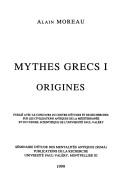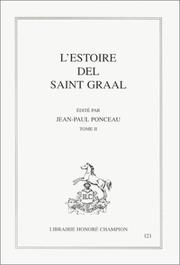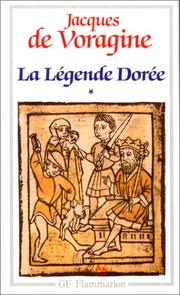| Listing 1 - 10 of 114 | << page >> |
Sort by
|

ISBN: 284269239X 2842693086 9782842692391 Year: 1999 Volume: 6 Publisher: Montpellier Université Paul-Valéry-Montpellier III
Abstract | Keywords | Export | Availability | Bookmark
 Loading...
Loading...Choose an application
- Reference Manager
- EndNote
- RefWorks (Direct export to RefWorks)
Mythology, Greek --- Legends --- Mythologie grecque --- Légendes --- Légendes
Book
ISBN: 2745302825 9782745302823 Year: 2000 Volume: no. 23 Publisher: Paris Champion
Abstract | Keywords | Export | Availability | Bookmark
 Loading...
Loading...Choose an application
- Reference Manager
- EndNote
- RefWorks (Direct export to RefWorks)
Mythology --- Christian legends --- Mythologie --- Légendes chrétiennes --- History and criticism --- Histoire et critique --- Légendes chrétiennes
Book
ISBN: 9782915540123 2915540128 Year: 2006 Publisher: Paris Chandeigne
Abstract | Keywords | Export | Availability | Bookmark
 Loading...
Loading...Choose an application
- Reference Manager
- EndNote
- RefWorks (Direct export to RefWorks)
Legends --- Folk literature, Portuguese --- Légendes --- Littérature populaire portugaise --- Légendes --- Littérature populaire portugaise
Book
ISBN: 2234016630 Year: 1980 Volume: 12 Publisher: Paris Stock
Abstract | Keywords | Export | Availability | Bookmark
 Loading...
Loading...Choose an application
- Reference Manager
- EndNote
- RefWorks (Direct export to RefWorks)
Hassidisme. --- Légendes juives. --- Ba'al Shem *Tov, --- Légendes juives. --- Baʻal Shem *Tov,

ISBN: 2852037246 2852037270 9782852037274 9782852037243 Year: 1997 Volume: 120-121 Publisher: Paris : Editions Honoré Champion,
Abstract | Keywords | Export | Availability | Bookmark
 Loading...
Loading...Choose an application
- Reference Manager
- EndNote
- RefWorks (Direct export to RefWorks)
Grail --- Christian legends --- Graal --- Légendes chrétiennes --- Legends --- Légendes --- -Graal --- Gral --- Gréal --- Holy Grail --- Sangraal --- Sangreal --- Chalices --- Folklore --- Romances --- Joseph of Arimathea, Saint --- -Romances --- Légendes chrétiennes --- Légendes --- Joseph of Arimathea --- Grail - Legends

ISBN: 2080701320 2080701339 9782080701329 Year: 1967 Volume: 132-133. Publisher: Paris Garnier-Flammarion
Abstract | Keywords | Export | Availability | Bookmark
 Loading...
Loading...Choose an application
- Reference Manager
- EndNote
- RefWorks (Direct export to RefWorks)
Iconographie religieuse --- Religion --- #GGSB: Geestelijke lezing (geel) --- #gsdb8 --- Christian saints --- Miracles --- Saints chrétiens --- Legends --- Légendes --- Geestelijke lezing (geel)
Book
ISBN: 1421427869 1421429144 9781421427867 Year: 2009 Publisher: Baltimore : Johns Hopkins University Press,
Abstract | Keywords | Export | Availability | Bookmark
 Loading...
Loading...Choose an application
- Reference Manager
- EndNote
- RefWorks (Direct export to RefWorks)
The Eve of Spain demonstrates how the telling and retelling of one of Spain’s founding myths played a central role in the formation of that country’s national identity. King Roderigo, the last Visigoth king of Spain, rapes (or possibly seduces) La Cava, the daughter of his friend and counselor, Count Julian. In revenge, the count travels to North Africa and conspires with its Berber rulers to send an invading army into Spain. So begins the Muslim conquest and the end of Visigothic rule. A few years later, in Northern Spain, Pelayo initiates a Christian resistance and starts a new line of kings to which the present-day Spanish monarchy traces its roots.Patricia E. Grieve follows the evolution of this story from the Middle Ages into the modern era, as shifts in religious tolerance and cultural acceptance influenced its retelling. She explains how increasing anti-Semitism came to be woven into the tale during the Christian conquest of the peninsula—in the form of traitorous Jewish conspirators. In the sixteenth century, the tale was linked to the looming threat of the Ottoman Turks. The story continued to resonate through the Enlightenment and into modern historiography, revealing the complex interactions of racial and religious conflict and evolving ideas of women’s sexuality.In following the story of La Cava, Rodrigo, and Pelayo, Grieve explains how foundational myths and popular legends articulate struggles for national identity. She explores how myths are developed around few historical facts, how they come to be written into history, and how they are exploited politically, as in the expulsion of the Jews from Spain in 1492 followed by that of the Moriscos in 1609. Finally, Grieve focuses on the misogynistic elements of the story and asks why the fall of Spain is figured as a cautionary tale about a woman’s sexuality.
Jews --- Muslims --- Christians --- Legends --- European history --- History. --- Spain --- Ethnic relations --- History --- Juifs --- Musulmans --- Chrétiens --- Légendes --- Histoire. --- Espagne --- Histoire
Book
ISBN: 9782960099744 2960099745 Year: 2013 Publisher: Bastogne Musée en Piconrue
Abstract | Keywords | Export | Availability | Bookmark
 Loading...
Loading...Choose an application
- Reference Manager
- EndNote
- RefWorks (Direct export to RefWorks)
Même laminée par la domination romaine, la culture celtique a survécu avec plus ou moins de vitalité en divers endroits de son ancienne zone d'expansion. Mais, le cycle arthurien mis à part, marginalisée et souvent additionnée d'apports ultérieurs, elle n'a plus été vécue que par les couches populaires - essentiellement paysannes - qui n'entraient pas en compte dans la culture officielle. Seuls quelques esprits ouverts et clairvoyants ont pu, dès le XIXe siècle, comprendre au travers de la littérature la valeur profonde, réelle, de ces traditions populaires qui évolueront elles-mêmes de façon non concertée. Ardenne et Bretagne, les soeurs lointaines entreprend de montrer combien, au-delà de formes parfois très diversifiées, un certain nombre d'éléments traditionnels populaires sont restés communs à ces deux régions éloignées par l'histoire et un millier de kilomètres, mais appartenant toutes deux au domaine celtique essentiel. Très amplement développé au départ de l'édition de 1989, cet ouvrage est enrichi d'une iconographie qui, en plus de documents relevant des traditions, réunit les noms d'un bel ensemble d'illustrateurs ardennais et bretons contemporains.
Folklore --- Ardennes (L) --- Brittany --- Ardennes (B) --- Ardennes (F) --- Légendes --- Ardenne (Belgique) --- Bretagne (France) --- Celts --- Belgium --- Ardennes --- France --- Brittany (France) --- Folklore - France - Brittany --- Folklore - Ardennes --- Légendes
Book
ISBN: 906798003X Year: 1984 Publisher: Aartselaar De Keyser
Abstract | Keywords | Export | Availability | Bookmark
 Loading...
Loading...Choose an application
- Reference Manager
- EndNote
- RefWorks (Direct export to RefWorks)
Folklore --- Brussels --- Brussel --- Bruxelles --- Mythes et légendes --- Sagen en legenden --- Legends --- Légendes --- Légendes --- Vlaanderen--mythen, sagen en legenden --- 870 --- proza --- prose
Book
ISBN: 2859442332 287854045X Year: 1993 Volume: 3 Publisher: Paris Presses de la Sorbonne Nouvelle
Abstract | Keywords | Export | Availability | Bookmark
 Loading...
Loading...Choose an application
- Reference Manager
- EndNote
- RefWorks (Direct export to RefWorks)
Legends --- Leyendas --- James --- Jacques --- Légendes --- Aragon (Spain) --- Spain --- Aragon (Espagne) --- Espagne --- Kings and rulers --- History --- Rois et souverains --- Histoire --- Légendes
| Listing 1 - 10 of 114 | << page >> |
Sort by
|

 Search
Search Feedback
Feedback About UniCat
About UniCat  Help
Help News
News